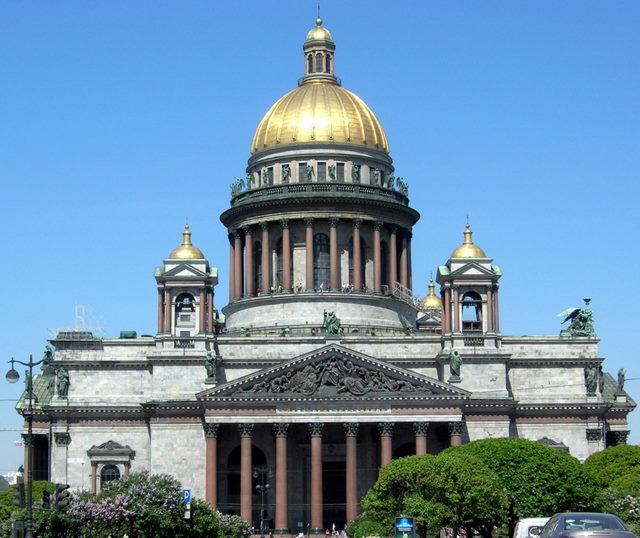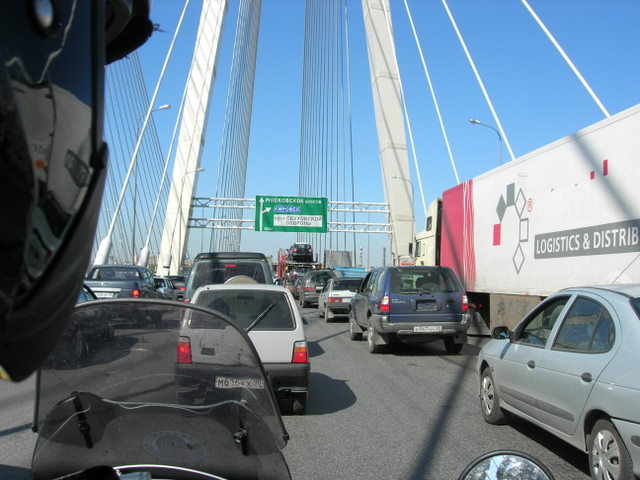St Petersburg
A few days in St Petersburg allow Mike and Jo to get a feel for the Russian West and to recall what the word expensive means.31 May to 5 June 08
Saint Petersburg, henceforth known as St Pete, is in the top left hand corner of the Russian Federation and is, therefore, the logical place to start a crossing of this country which ends at Vladivostok, henceforth known as Vlad, located in the bottom right hand corner. It is almost a bonus that this is a legendary city, famed for its beauty, its cultural treasures and its heroic history in defying the Nazi Army in a bloody two year siege.
We knew the city would be easy enough to find, it is hard to misplace 4.5 million people, but our pre-booked hotel was another concern. We had no paper maps and only some general digital maps for the GPS. The best we could do was to find the Lat/Long of the suburb from Google, pick a point and set it as a GPS destination and then use this as a general guide of direction through the city. As it turned out, this took us through the centre of town on a busy Saturday, but it got us to the correct suburb where one stop for directions at a servo found us settled with time to spare.
The city was largely rebuilt after WWII but is still a monumental. St Isaac's Cathedral gives a feel for the grand style of the place.

Although some of it, like the south portico of the New Hermitage...

...is a little excessive for our tastes.
The city is built on the delta of the Neva River and has water, and mosquitoes,everywhere. It also has some nice canals complete with ferries to move the locals and tourist boats to move the terrorists.

This leaves some beautiful streets where the most elegant of the old houses are positioned along the canals.

I particularly liked the view along the canal to the Church of the Saviour on Spilled Blood with its colourful onion domes shining in the late afternoon sun.

There are few reminders of the destruction of WWII, but this stenciled sign on a city wall has been kept fresh as a memorial.

It warns citizens that they are on the side of the street most dangerous in an artillery attack!
Interestingly, although we stayed way out in the suburbs, where the tariff was still extortionate, getting around was easy. The city has a great metro system. It is fast, clean and cheap, and....

...a long way underground!! It dropped us in our suburb, which was a tourist free zone, near a nice supermarket.
The first time we went in to buy some dinner on the way home we were reminded of the time during the Cold War when there were many shortages of consumer items. The belief in the West at the time was that it was no use talking to people about human rights if they had other, more basic, problems on their mind: like feeding the family.
It was obvious at the first stop that...

... the Russians had achieved The Freedom of the Sausage. We were yet to see if this translated into other freedoms as we had hypothesized.
Of course, the thing that everyone has to see in St Pete is the Hermitage; the rightly famous museum and custodian of a goodly share of the West's cultural heritage.

The building itself is impressively large without being excessive in the way of other some grand buildings.
We queued for an hour to get in and intentionally left our camera behind so that we could concentrate on the art. This turned out to be a mistake, not because we needed a digitally enhanced Matisse or two to liven up the blog, but because the antics of some of the other visitors were worthy of recording.
The Hermitage is simply amazing! There are not just one or two, or a few, of each of the important artists. There are so many that they fight for space in this gigantic complex. There are rooms full of Picassos, truck loads of Rembrandts, a shed full of Renoirs, Gauguins a dime a dozen, and a gaggle of El Grecos. It would take a week to give the displayed part of the collection a cursory once-over. The millions of pieces not on display are another story altogether.
Jo had done some excellent research on the collection so we concentrated our day on the major European art. We bypassed all galleries that were not on the plan, made straight for the areas of interest and stuck to our task all day, and, it was amazing and worthwhile.
The place was crowded and it was impossible to ignore the crush. Two groups struck us as interesting. The first were the digital camera users. Having paid a small extra fee to use their cameras, they rushed up to each painting pausing long enough to focus it on the screen, before pressing the shutter and rushing off.
We discussed what they might do with the images. Did they take them home, blow them up to life size and study them at their leisure? Would this allow them to understand the emptiness in the eyes of Picasso's Absinthe Drinker that had left us so troubled? And how did they reconcile that they had only ever seen these things vicariously through a 2 inch LED screen?
The second group of interest was the tour group inmates. They caterpillared their way through the building, milling along. Each group followed a leader holding aloft a marker showing the name of their cruise ship or tour. They walked on in silence as each individual had a headset connected to a small radio receiver. The guides talked continually into a headset-mic pointing out some facts of interest for selected exhibits as they passed. There was time only for a glance. There was no time to linger.
Often, groups would pass in opposite directions. Mauls of aging Americans and well-to-do Japanese, each listening to their own drummer, played out a silent ballet of side-stepping, worried only about falling behind the voice in their heads.
Some group tours were no doubt better than others, but it seemed to us that most would simply allow the members to say that they had been to the Hermitage, and maybe to recall a few facts, but nothing more.
Our final observation on the Hermitage concerns the exhibition itself. There are so many exhibits jostling for wall space that much is not shown to advantage. Most of the paintings are framed in glass. This reflected the poor lighting, overlaying a reflection of the observer on the image that caused us to constantly shift position to see different details. Some were so poorly lit that a clear view was not possible from any angle.
We have many thoughts about our visit to the Hermitage, but it is too early in our exploration of Russia to make much sense of it yet. We are, however, very pleased we went and satisfied that the $16 entrance fee was well spent.
Having arrived into St Pete through the centre of the city, we cunningly planned our escape by heading out to join a ring-road running around the eastern boundary. We found the ring-road without trouble and thought we were onto a winner as we thundered south on an 8 lane freeway. Our smugness lasted about 15 km until the traffic ground to walking pace and we found ourselves trapped in the middle of ...

...a good old fashioned traffic jam. The Elephant got hot. Aging Ladas boiled and stopped in the middle of lanes adding to the congestion. Ancient trucks covered everything in a pall of black diesel soot. It took more than an hour to inch forward to the cause of the problem and break free. Six lanes over a new bridge merged into two lanes at the place where an on-ramp added traffic from the city!
We were starting to learn that things aren't always what they seem in Russia.
